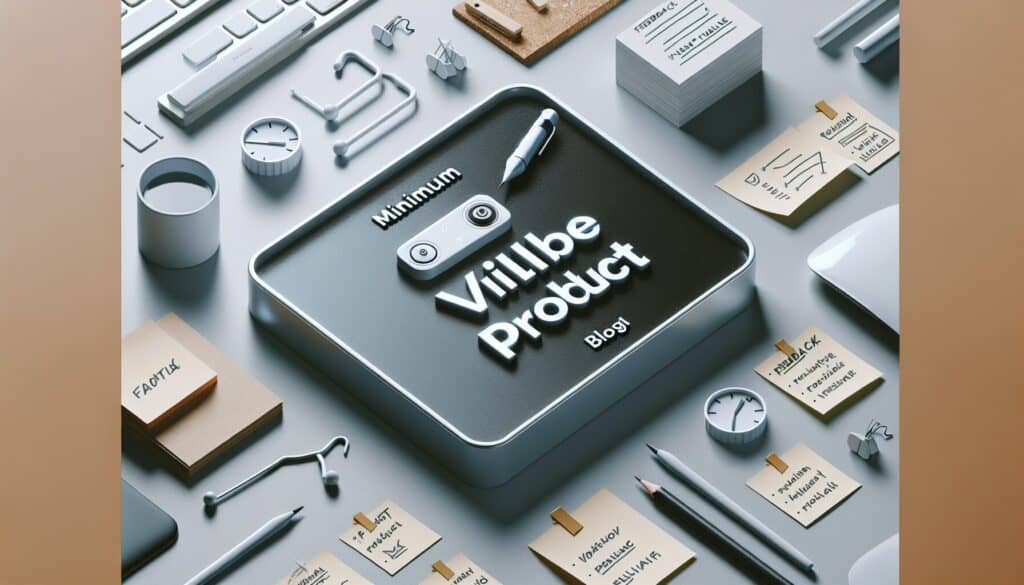Lancer un nouveau produit avec juste assez de fonctionnalités pour attirer les premiers clients et valider une idée de produit dès le début du cycle de développement du produit.
- Méthodologies : Ingénierie, Qualité
Produit minimum viable (MVP)

Produit minimum viable (MVP)
- Méthodologie Agile, Développement agile de produits, Développement itératif, Produit minimum commercialisable (PMC), Produit minimum viable (MVP), Prototypage, Expérience utilisateur (UX), User-Centered Design, Validation
Objectif :
Comment il est utilisé :
- Les équipes de développement élaborent une version de base du produit avec des fonctionnalités essentielles afin de tester des hypothèses, de recueillir les réactions des utilisateurs et d'apprendre ce qui plaît au public cible avec un investissement minimal en ressources.
Avantages
- Valide rapidement les idées de produits, minimise les coûts et les risques de développement, facilite l'apprentissage et l'itération sur la base de données d'utilisateurs réels.
Inconvénients
- Risque de lancer un produit trop basique et de décevoir les utilisateurs, risque d'impressions initiales négatives en cas de mauvaise gestion, risque de ne pas être suffisant pour tester la véritable demande du marché.
Catégories :
- Idéation, Lean Sigma, Résolution de problèmes, Conception de Produits
Idéal pour :
- Tester rapidement une hypothèse de base sur un produit et recueillir les réactions des utilisateurs avec un minimum d'efforts et de ressources.
Le Produit minimum viable (MVP) est souvent utilisée dans des secteurs tels que la technologie, les biens de consommation et les soins de santé, où l'itération rapide basée sur le retour d'information des utilisateurs est essentielle au succès. Cette approche est particulièrement bénéfique pendant la phase de développement du produit, car elle permet aux équipes de tester les hypothèses concernant les besoins des utilisateurs et leurs préférences en matière de fonctionnalités avec une version de base de leur offre. Par exemple, une startup technologique peut lancer une application mobile simplifiée dépourvue de fonctions avancées, en se concentrant plutôt sur les fonctionnalités de base qui répondent à un problème spécifique. Cela permet à l'entreprise de recueillir des données cruciales sur les interactions et la satisfaction des utilisateurs, et d'orienter le développement ultérieur avec un investissement initial minimal. Généralement, le développement initial du MVP est initié par les chefs de produit ou les entrepreneurs, mais il implique idéalement une équipe interfonctionnelle comprenant des concepteurs, des développeurs et des professionnels du marketing qui peuvent apporter des perspectives diverses sur la facilité d'utilisation et la commercialisation. Des secteurs tels que la fintech et le commerce électronique adoptent fréquemment cette stratégie, car l'évolution rapide des préférences des consommateurs nécessite une validation efficace des nouveaux concepts. La collecte des commentaires des utilisateurs lors des tests MVP peut conduire à des améliorations itératives, garantissant que les produits finaux sont plus alignés sur la demande du marché, réduisant ainsi les pivots coûteux plus tard dans le processus de développement. La capacité d'impliquer les utilisateurs dès le début avec un produit tangible, même sous sa forme la plus basique, crée une base pour un dialogue et une innovation continus.
Principales étapes de cette méthodologie
- Identifier le problème principal à résoudre en fonction des besoins du marché.
- Définir les principales caractéristiques requises pour résoudre le problème identifié.
- Créer un prototype avec les fonctionnalités essentielles pour un développement rapide.
- Lancer le MVP auprès d'un public sélectionné pour obtenir un premier retour d'information.
- Contrôler les interactions avec les utilisateurs et recueillir un retour d'information qualitatif.
- Analyser les données pour valider ou invalider les hypothèses sur les produits.
- Améliorer le produit en affinant les caractéristiques sur la base du retour d'information.
- Répétez le processus avec les versions suivantes pour améliorer le produit.
Conseils de pro
- Mener des entretiens approfondis avec les utilisateurs avant le développement du MVP afin d'identifier les points douloureux et les attentes, en veillant à ce que les fonctionnalités de base répondent réellement aux besoins des utilisateurs.
- Mettre en œuvre rapidement des tests A/B dans le cadre du MVP afin d'évaluer différentes variantes de fonctionnalités, ce qui permet de prendre des décisions fondées sur des données afin de hiérarchiser les améliorations.
- Incorporer un cadre analytique solide dès le départ pour capturer les données d'interaction de l'utilisateur, permettant des itérations éclairées qui s'alignent sur le comportement et les préférences de l'utilisateur.
Lire et comparer plusieurs méthodologies, nous recommandons le
> Référentiel méthodologique étendu <
ainsi que plus de 400 autres méthodologies.
Vos commentaires sur cette méthodologie ou des informations supplémentaires sont les bienvenus sur le site web de la Commission européenne. section des commentaires ci-dessous ↓ , ainsi que toute idée ou lien en rapport avec l'ingénierie.
Contexte historique
1949
1950
1950
1960
1960
1960
1960
1940
1950
1950
1958
1960
1960
1960
1960
(si la date est inconnue ou n'est pas pertinente, par exemple "mécanique des fluides", une estimation arrondie de son émergence notable est fournie)















Articles Similaires
Calculateur de METS en calories
Méta-analyse
Cartographie des messages
Diagrammes du modèle mental
Forces de poussée et de traction maximales acceptables
Planification des besoins en matériaux (MRP)